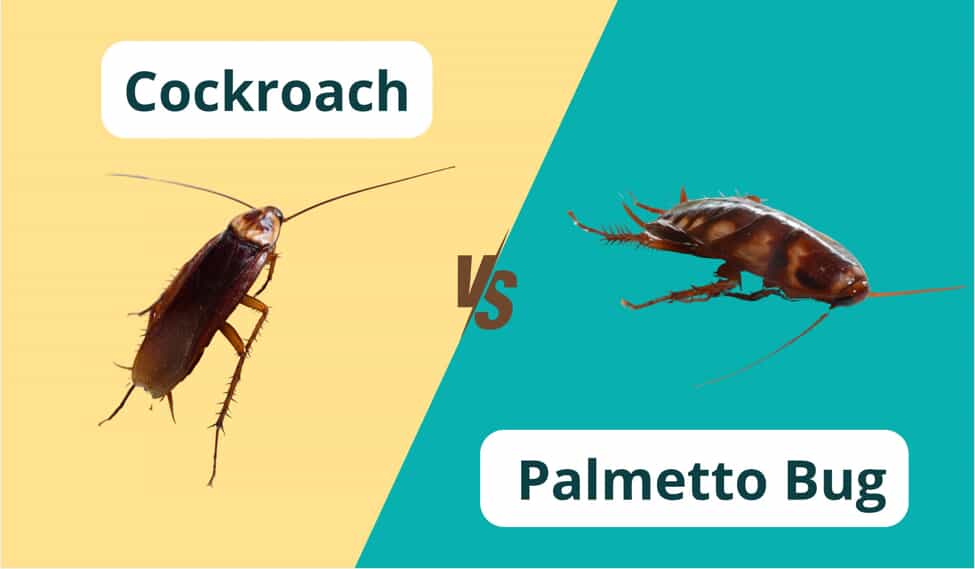Cockroaches vs. Palmetto Bugs: What’s the Difference?
Cockroaches and "palmetto bugs" often get mixed up, but here's the deal: they're pretty much the same critters.
So, how do you spot the difference in your home? Stick around to learn how to tell these speedy bugs apart and keep your home pest-free.
Key Takeaways
- Palmetto bugs are a type of cockroach that is often found in Florida.
- Florida hosts various cockroach species, including the American, German, Smoky Brown, Florida Woods, and Oriental cockroaches.
- Cockroaches and palmetto bugs differ in size, color, wing development, and preferred habitats, with palmetto bugs generally larger and more outdoor-oriented.
- Cockroaches/Palmetto bugs can spread diseases like Salmonella and E. coli, and their presence can exacerbate allergies and asthma, especially in indoor environments.
- Identifying and managing infestations requires vigilance for signs like droppings and egg cases, DIY methods like boric acid bait, and professional pest control for persistent issues.
Understanding Palmetto Bugs in Florida
Palmetto bugs are typical in warm, humid regions, particularly in Florida. They are not only a common annoyance but also a notable member of the cockroach family.
What Are Palmetto Bugs?
In Florida, the term "palmetto bug" often refers to the adult American cockroaches, which thrive in the state's tropical climate.
This cockroach species is often considered the "real" palmetto bug, especially in the southern and southeastern United States, such as South Carolina.
Despite their name, palmetto bugs are not exclusive to palmetto trees. However, these trees provide them with a typical habitat.
Besides checking for long antennae, recognizing a palmetto bug is straightforward if you know what to look for despite being often mistaken for water bugs:
Appearance | Description |
Size | Up to 1.5 inches long |
Color | Typically reddish-brown to black |
Wings | Shorter than many other cockroaches, appearing underdeveloped |
Speed | Notably, they are less agile compared to common cockroaches |
Types of Cockroaches in Florida
Florida is home to many different species of cockroaches, each with distinctive characteristics. These versatile, hardy insects can adapt to various environments.
Here’s a closer look at some of the most prevalent roach species found in the state:
American Cockroach
Scientific Name: Periplaneta americana
- Identifying Features: Reddish-brown, large cockroaches about 1.5 inches in length, wings
- Habitats: Warm, moist areas, sewers, basements
German Cockroach
Scientific Name: Blattella germanica
- Identifying Features: Light brown, two dark stripes on the back, about 0.6 inches
- Habitats: Kitchens, bathrooms, indoor settings
Smoky Brown Cockroach
Scientific Name: Periplaneta fuliginosa
- Identifying Features: Uniform dark brown, about 1.2 inches
- Habitats: Attics, crawl spaces, outdoor foliage
Florida Woods Cockroach
Scientific Name: Eurycotis floridana
- Identifying Features: Dark brown to black, larger at about 1.6 inches, emits a defensive odor
- Habitats: Yards with heavy foliage, tree hollows
Oriental Cockroach
Scientific Name: Blatta orientalis
- Identifying Features: Dark brown or black, about 1 inch, prefers cooler temperatures
- Habitats: Damp, dark areas like drains, under debris
Identifying Signs of Infestations

Cockroaches and palmetto bugs leave similar evidence of their unwelcome presence when scouting for signs of an infestation in a home.
Here's what you should keep an eye out for as homeowners in Florida:
Signs | Description |
Droppings | Their feces look like small, black, or brown specks or pellets. |
Egg Cases | Both pests lay oblong, dark brown egg cases (oothecae). |
Odor | A musty, oily smell can be a telltale of a cockroach infestation, which strengthens with more significant numbers. |
Damage | Look for chew marks on food packaging, books, and leather. |
Sightings | Seeing live or dead cockroaches and palmetto bugs, particularly during the day. |
At-Home Cockroach Control Strategies
Effective management requires a combination of do-it-yourself diligence and professional pest control services for cockroaches and palmetto bug infestations.
The right approach can keep these pests at bay and prevent them from recurring problems in places like sewers, basements, mulch, and other humid areas.
DIY Control Methods
Controlling cockroaches and palmetto bugs can start with a few natural methods. One popular approach is the use of boric acid.
Here’s a simple guide:
- Mix equal parts of boric acid, flour, and sugar to create a bait that attracts the pests.
- Place the bait in shallow containers or dust it in areas where the insects are frequently spotted, such as kitchen cabinets and behind appliances.
For outdoor prevention, make sure to follow this checklist:
- keep wood piles away from your home’s foundation
- regularly clean gutters
- minimize the use of mulch near your home's perimeter
Why Call Professional Pest Control?
Like bed bug infestations, key indicators signal the need for a professional exterminator for problems with cockroaches and palmetto bugs.
These include:
Key Indicators | Description |
Persistent Presence | If you consistently find cockroaches or palmetto bugs despite your DIY efforts, it's time to call in the professionals. |
Rapid Reproduction | These pests can reproduce quickly, so a small problem can become a large infestation quickly. |
Potential Damage | While cockroaches and palmetto bugs aren't known to cause damage like termites, their presence suggests other potential pest control issues. |
Health Concerns | Professional pest control services have the correct tools and techniques to handle infestations. |
Preventative Measures | A pest management professional can offer solutions to prevent future infestations. |
Should You Seek Out the Experts?
When dealing with cockroaches or palmetto bugs, many of you squirm at the thought of these critters scuttling through your homes. Sometimes, ensuring a bug-free zone means reaching out for help.
So, if cockroaches and palmetto bugs are becoming all too familiar faces around your abode, picking up the phone to bring in pest control professionals (like us, Native Pest Management) might just be the smart move.
